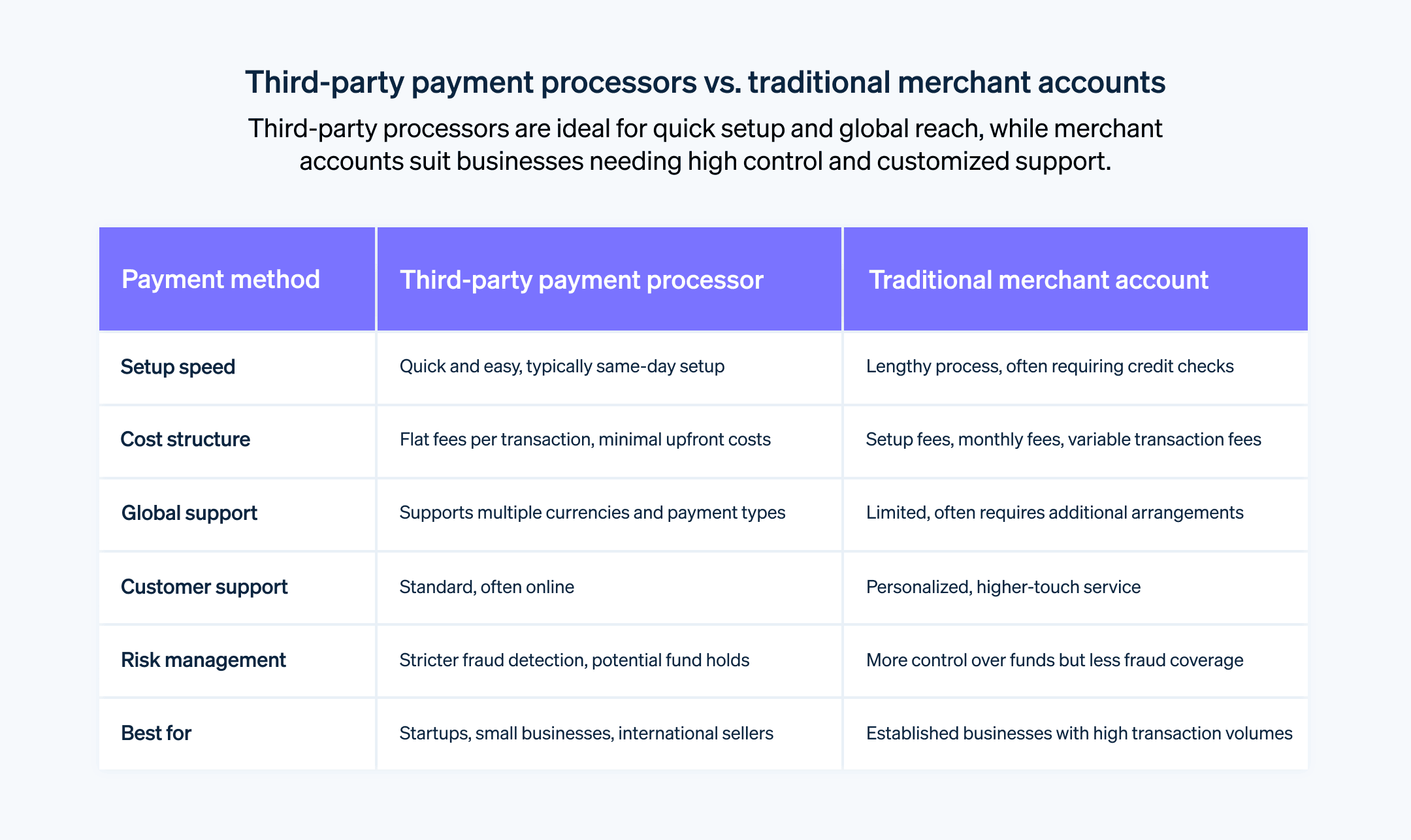รายงานปี 2022 พบว่าธุรกรรมออนไลน์คิดเป็น 20% ของยอดขายรวมทั่วโลก และมีการคาดการณ์ว่าจะสูงถึง 24% ภายในปี 2026 ในปัจจุบัน ผู้ประมวลผลการชำระเงินของบุคคลที่สามมีความสำคัญมากกว่าที่เคย ทั้งในการอำนวยความสะดวกให้การชำระเงินที่รวดเร็วและปลอดภัยสำหรับธุรกิจประเภทต่างๆ ตั้งแต่ธุรกิจสตาร์ทอัพที่เพิ่งเริ่มต้นกิจการ ไปจนถึงร้านค้าออนไลน์ที่ก่อตั้งมานาน
สำหรับธุรกิจส่วนใหญ่ที่จัดการธุรกรรมลูกค้า การทำความเข้าใจแพลตฟอร์มเหล่านี้ถือเป็นสิ่งสำคัญ ผู้ประมวลผลการชําระเงินที่เหมาะสมจะช่วยยกระดับประสบการณ์ของลูกค้า ปรับปรุงการดําเนินงาน และทำให้เข้าถึงตลาดใหม่ๆ ได้อย่างมีประสิทธิภาพมากขึ้น ต่อไปนี้คือสิ่งที่คุณควรทราบเกี่ยวกับผู้ประมวลผลการชําระเงินบุคคลที่สาม และวิธีเลือกผู้ให้บริการที่เหมาะสมกับธุรกิจของคุณ
บทความนี้ให้ข้อมูลอะไรบ้าง
- ผู้ประมวลผลการชําระเงินบุคคลที่สามคืออะไร
- การประมวลผลการชําระเงินโดยบุคคลที่สามทํางานอย่างไร
- ข้อดีข้อเสียของการทํางานร่วมกับผู้ประมวลผลการชําระเงินบุคคลที่สาม
- การเลือกผู้ประมวลผลการชําระเงินบุคคลที่สาม
ผู้ประมวลผลการชําระเงินบุคคลที่สามคืออะไร
ผู้ประมวลผลการชําระเงินบุคคลที่สามคือบริการที่ช่วยให้ธุรกิจต่างๆ รับการชําระเงินออนไลน์ได้ ผู้ประมวลผลการชําระเงินเหล่านี้ช่วยอํานวยความสะดวกในการทําธุรกรรมระหว่างลูกค้าและธุรกิจ โดยการโอนเงินจากบัญชีธนาคารหรือเครดิตของลูกค้าไปยังบัญชีธนาคารของธุรกิจ
การประมวลผลการชําระเงินโดยบุคคลที่สามทํางานอย่างไร
ผู้ประมวลผลการชําระเงินบุคคลที่สามช่วยให้ธุรกิจสามารถรับวิธีการชําระเงินออนไลน์ที่หลากหลาย โดยไม่ต้องตั้งค่าและดูแลบัญชีผู้ค้าของตัวเองผ่านธนาคาร สิ่งนี้เป็นประโยชน์อย่างมาก โดยเฉพาะอย่างยิ่งสำหรับธุรกิจขนาดเล็กหรือธุรกิจใหม่ เนื่องจากการทำงานร่วมกับผู้ประมวลผลการชำระเงินอาจเป็นวิธีเริ่มรับการชำระเงินออนไลน์ที่รวดเร็วและเข้าถึงได้ง่ายกว่า
บัญชีผู้ค้าแบบดั้งเดิมคือบัญชีธนาคารประเภทหนึ่งที่ช่วยให้ธุรกิจต่างๆ รับการชําระเงินได้หลากหลายวิธี โดยส่วนใหญ่แล้วจะเป็นบัตรเดบิตหรือเครดิต และกระเป๋าเงินดิจิทัล ในโมเดลนี้ ธุรกิจแต่ละแห่งจะมีบัญชีผู้ค้าที่ไม่ซ้ำกัน และบัญชีเหล่านี้มาพร้อมกับข้อกำหนดและค่าธรรมเนียมการประเมินและควบคุม เช่น ค่าธรรมเนียมการตั้งค่า ค่าธรรมเนียมรายเดือน และค่าธรรมเนียมธุรกรรม โดยทั่วไป บัญชีผู้ค้ายังมีขั้นตอนการตั้งค่านานกว่า วิธีการตั้งค่าผู้ประมวลผลการชำระเงินบุคคลที่สาม
ผู้ประมวลผลการชําระเงินบุคคลที่สาม เช่น Stripe รวมธุรกรรมของลูกค้าทั้งหมดไว้ในบัญชีผู้ค้าบัญชีเดียว จึงช่วยให้ธุรกิจเข้าถึงฟังก์ชันของบัญชีผู้ค้าได้อย่างมีประสิทธิภาพ โดยไม่ต้องผ่านกระบวนการเปิดบัญชีด้วยตัวเองที่ใช้เวลานาน
ต่อไปนี้คือภาพรวมความแตกต่างที่สําคัญๆ ระหว่างผู้ประมวลผลการชําระเงินบุคคลที่สามกับบัญชีผู้ค้า
ความเร็วและความเรียบง่าย
สําหรับธุรกิจ การตั้งค่าผู้ประมวลผลการชําระเงินบุคคลที่สามจะรวดเร็วและง่ายกว่าการเปิดบัญชีผู้ค้า เมื่อใช้บัญชีผู้ค้าแบบดั้งเดิม กระบวนการตั้งค่าอาจใช้เวลานานและมักต้องผ่านการตรวจสอบเครดิตโดยละเอียดและตรวจสอบความมั่นคงทางการเงินของธุรกิจโครงสร้างต้นทุน
โดยทั่วไปแล้ว ผู้ประมวลผลบุคคลที่สามจะเรียกเก็บค่าธรรมเนียมคงที่ต่อธุรกรรม ในขณะที่บัญชีผู้ค้ามักจะเก็บค่าธรรมเนียมการตั้งค่า ค่าธรรมเนียมรายเดือน และค่าธรรมเนียมธุรกรรมแบบแปรผัน สําหรับธุรกิจขนาดเล็กหรือธุรกิจที่มียอดขายน้อยกว่า โครงสร้างค่าใช้จ่ายของผู้ประมวลผลบุคคลที่สามจะมีประสิทธิภาพมากกว่าของบัญชีผู้ค้าการจัดการความเสี่ยง
เนื่องจากผู้ประมวลผลบุคคลที่สามรวบรวมธุรกรรมจากหลายธุรกิจ จึงมักจะมีระบบตรวจจับการฉ้อโกงที่เข้มงวดกว่า และอาจมีแนวโน้มที่จะอายัดบัญชีหรือระงับเงินเมื่อตรวจพบกิจกรรมที่น่าสงสัยฝ่ายสนับสนุนลูกค้า
บัญชีผู้ค้ามักจะให้การสนับสนุนลูกค้าที่ปรับให้เหมาะกับคุณมากขึ้น ในขณะที่ผู้ประมวลผลบุคคลที่สามมักจะให้การสนับสนุนออนไลน์ตามมาตรฐานที่ปรับให้เหมาะกับผู้ใช้แต่ละรายน้อยกว่า เนื่องจากร่วมงานกับธุรกิจจํานวนมากความยืดหยุ่นในการชําระเงิน
ผู้ประมวลผลบุคคลที่สามมักจะรองรับวิธีการชําระเงินและสกุลเงินที่หลากหลายกว่า ซึ่งอาจเป็นประโยชน์ต่อธุรกิจที่ดําเนินงานในต่างประเทศหรือต้องการให้ลูกค้ามีตัวเลือกการชําระเงินมากขึ้น ตัวอย่างเช่น Stripe รองรับมากกว่า 135 สกุลเงิน ซึ่งช่วยให้ธุรกิจดําเนินงานได้ในตลาดทั่วโลกที่หลากหลายและรับการเบิกจ่ายในสกุลเงินที่ต้องการ
แม้ว่าผู้ประมวลผลการชําระเงินบุคคลที่สามจะมอบวิธีที่ง่ายและรวดเร็วในการเริ่มรับชําระเงินออนไลน์ แต่ธุรกิจก็มีความเสี่ยงเช่นกัน การเลือกระหว่างผู้ประมวลผลบุคคลที่สามและบัญชีผู้ค้าแบบดั้งเดิมจะขึ้นอยู่กับความต้องการและสถานการณ์เฉพาะของธุรกิจ

ข้อดีข้อเสียของการทํางานร่วมกับผู้ประมวลผลการชําระเงินบุคคลที่สาม
การทํางานร่วมกับผู้ประมวลผลการชําระเงินบุคคลที่สามอาจมอบข้อดีหลายประการแก่ธุรกิจ โดยเฉพาะสําหรับธุรกิจขนาดเล็กหรือธุรกิจสตาร์ทอัพ อย่างไรก็ตาม ผู้ประมวลผลการชําระเงินก็มีความท้าทายเช่นกัน นี่คือข้อดีข้อเสียของผู้ประมวลผลการชําระเงินบุคคลที่สาม
ข้อดี
ตั้งค่าได้ง่าย
ผู้ประมวลผลการชําระเงินบุคคลที่สามมักจะตั้งค่าได้ง่ายและรวดเร็วกว่า เมื่อเทียบกับบัญชีผู้ค้าแบบเดิมๆ ตัวอย่างเช่น Stripe ช่วยให้ธุรกิจเริ่มรับชําระเงินได้อย่างรวดเร็วด้วยไลบรารี API ที่เหมาะสําหรับนักพัฒนา พร้อมด้วยโซลูชันแบบสําเร็จรูปหรือเขียนโค้ดเพียงเล็กน้อยค่าใช้จ่ายเบื้องต้นต่ำกว่า
โดยทั่วไปแล้วไม่มีค่าธรรมเนียมการตั้งค่าหรือค่าธรรมเนียมรายเดือนสําหรับผู้ประมวลผลการชําระเงินบุคคลที่สาม ทําให้วิธีนี้เป็นตัวเลือกที่มีราคาย่อมเยากว่าสําหรับธุรกิจขนาดเล็กหรือผู้ที่มียอดขายไม่มาก นี่คือภาพรวมของโครงสร้างค่าบริการที่เรียบง่ายและโปร่งใสของ Stripeธุรกรรมทั่วโลก
วิธีนี้มักรองรับสกุลเงินและวิธีการชําระเงินที่หลากหลาย ซึ่งช่วยให้ธุรกิจจําหน่ายสินค้าและบริการให้ลูกค้าทั่วโลกได้ง่ายขึ้นขั้นตอนการชําระเงินที่เรียบง่าย
วิธีนี้ช่วยจัดการกระบวนการชําระเงินทุกแง่มุม รวมถึงการรักษาความปลอดภัยของการชําระเงิน การตรวจจับการฉ้อโกง และการปฏิบัติตามระเบียบข้อบังคับของอุตสาหกรรมการชําระเงิน
ข้อเสีย
ค่าธรรมเนียมธุรกรรมสูงกว่า
ผู้ประมวลผลการชําระเงินบุคคลที่สามมักจะเรียกเก็บค่าธรรมเนียมต่อธุรกรรมที่สูงกว่าเมื่อเทียบกับบัญชีผู้ค้าแบบเดิม อย่างไรก็ตาม อาจไม่เป็นเช่นนั้นเสมอไป และขึ้นอยู่กับผู้ให้บริการที่คุณร่วมงานด้วยความเสี่ยงในการระงับหรืออายัดเพิ่มขึ้น
เนื่องจากผู้ประมวลผลจัดการกับธุรกิจจํานวนมาก บางครั้งก็จะอายัดบัญชีหรือกันเงินทุนไว้โดยอัตโนมัติเมื่อตรวจพบกิจกรรมที่น่าสงสัยการควบคุมที่น้อยกว่า
เมื่อใช้ผู้ประมวลผลบุคคลที่สาม ธุรกิจจะมีอํานาจควบคุมกระบวนการทําธุรกรรมน้อยลง และต้องพึ่งพาระบบและกฎของผู้ประมวลผลการสนับสนุนลูกค้าน้อยกว่า
เนื่องจากธุรกิจให้บริการในปริมาณมาก ผู้ประมวลผลบุคคลที่สามจึงอาจไม่สามารถมอบการบริการลูกค้าในระดับเดียวกันกับบัญชีผู้ค้าเฉพาะ แม้อาจไม่เป็นเช่นนั้นเสมอไป แต่ก็เป็นสิ่งที่คุณควรคํานึงถึงเมื่อประเมินตัวเลือก
แน่นอนว่าผู้ประมวลผลการชําระเงินบุคคลที่สามบางรายอาจไม่ได้มีข้อดีข้อเสียที่เหมือนกัน แต่จะแตกต่างกันไป โดยขึ้นอยู่กับคุณภาพของผู้ให้บริการและระดับการตอบโจทย์ความต้องการของธุรกิจที่เฉพาะเจาะจง
การเลือกผู้ประมวลผลการชําระเงินบุคคลที่สาม
การเลือกผู้ประมวลผลการชําระเงินบุคคลที่สามที่เหมาะสมอาจเป็นการตัดสินใจที่สําคัญสําหรับธุรกิจของคุณ ผู้ประมวลผลที่เหมาะสมจะช่วยให้กระบวนการชําระเงินของคุณง่ายขึ้น ช่วยให้ธุรกรรมราบรื่นขึ้นสําหรับลูกค้า และแม้แต่การขยายตลาดในอนาคต อย่างไรก็ตาม การเลือกที่ผิดพลาดอาจทำให้เกิดค่าธรรมเนียมที่สูงโดยไม่จำเป็น บริการหยุดชะงัก หรือเกิดปัญหากับธุรกรรมของลูกค้า ด้วยตัวเลือกที่มีให้เลือกมากมาย โปรดพิจารณาความต้องการและสถานการณ์เฉพาะของธุรกิจของคุณก่อนตัดสินใจ ต่อไปนี้คือปัจจัยสําคัญที่ควรคํานึงถึง
ทําความเข้าใจความต้องการทางธุรกิจของคุณ
ธุรกิจทุกแห่งมีเอกลักษณ์เฉพาะตัว ลองพิจารณาปัจจัยต่างๆ เช่น ยอดขาย ขนาดธุรกรรมเฉลี่ย ประเภทผลิตภัณฑ์หรือบริการที่คุณขาย และวิธีการชําระเงินที่ลูกค้าต้องการ ตัวอย่างเช่น หากคุณกำลังดำเนินกิจการร้านค้าออนไลน์ที่ให้บริการลูกค้าในต่างประเทศ คุณจะต้องการผู้ประมวลผลที่รองรับสกุลเงินและวิธีการชำระเงินหลากหลาย ขณะที่ธุรกิจขนาดเล็กที่มีหน้าร้านค้าปลีกไม่กี่แห่งในตลาดที่มีลักษณะจำกัด อาจไม่จำเป็นต้องได้รับการสนับสนุนประเภทดังกล่าว
ประเมินโครงสร้างค่าธรรมเนียม
ผู้ประมวลผลการชําระเงินแต่ละรายมีโครงสร้างค่าธรรมเนียมที่แตกต่างกัน บางรายการอาจเรียกเก็บค่าธรรมเนียมคงที่ต่อธุรกรรม ในขณะที่บางรายการอาจเรียกเก็บเป็นเปอร์เซ็นต์ของมูลค่าธุรกรรม ระวังค่าธรรมเนียมแอบแฝง เช่น ค่าธรรมเนียมการดึงเงินคืน ค่าธรรมเนียมรายเดือน หรือค่าธรรมเนียมการยกเลิกการใช้งาน โปรดทําความเข้าใจค่าใช้จ่ายเหล่านี้และผลกระทบที่จะมีต่อผลกําไรของคุณ
พิจารณาวิธีการชําระเงินที่รองรับ
ลูกค้าของคุณอาจต้องใช้วิธีการชําระเงินที่หลากหลาย เช่น บัตรเครดิต บัตรเดบิต กระเป๋าเงินดิจิทัล หรือการโอนเงินผ่านธนาคาร การเลือกผู้ประมวลผลการชําระเงินที่รองรับวิธีการชําระเงินที่หลากหลายจะช่วยปรับปรุงประสบการณ์ของลูกค้าและอาจช่วยเพิ่มยอดขายได้
ตรวจสอบชื่อเสียงและความน่าเชื่อถือของผู้ประมวลผล
มองหารีวิวหรือคำบอกเล่าจากธุรกิจอื่นๆ ศึกษาความน่าเชื่อถือของบริการผู้ประมวลผลและความถี่ในการหยุดทํางาน นอกจากนี้ให้พิจารณาชื่อเสียงด้านการบริการลูกค้าของผู้ประมวลผลรายนั้นๆ หากคุณเลือกที่จะใช้บริการและประสบปัญหา คุณจะต้องการการสนับสนุนลูกค้าที่มีประโยชน์และทันท่วงที โดยควรเป็นช่องทางที่หลากหลาย (อีเมล แชท โทรศัพท์ เป็นต้น)
ประเมินความปลอดภัย
ตรวจสอบว่าผู้ประมวลผลการชําระเงินปฏิบัติตามมาตรฐานการรักษาความปลอดภัยที่เกี่ยวข้องทั้งหมด เช่น PCI DSS (มาตรฐานการรักษาความปลอดภัยข้อมูลสําหรับอุตสาหกรรมบัตรชําระเงิน) นอกจากนี้ ผู้ประมวลผลยังควรใช้การเข้ารหัสและมาตรการรักษาความปลอดภัยอื่นๆ เพื่อปกป้องข้อมูลการชําระเงินของลูกค้าด้วย
พิจารณาการปรับขนาด
เมื่อธุรกิจของคุณเติบโตขึ้น ความต้องการด้านการประมวลผลการชําระเงินของคุณอาจเปลี่ยนแปลงได้ เลือกผู้ประมวลผลที่สามารถปรับขนาดไปพร้อมกับธุรกิจของคุณและจัดการปริมาณธุรกรรมที่เพิ่มขึ้นได้ตามต้องการ
การเลือกผู้ประมวลผลการชําระเงินบุคคลที่สามเป็นการตัดสินใจที่สําคัญ การให้เวลาตัวเองในการค้นคว้าตัวเลือกและตัดสินใจอย่างมีข้อมูลประกอบ จะทำให้คุณสามารถร่วมมือกับผู้ประมวลผลการชำระเงินที่จะสนับสนุนเป้าหมายทางธุรกิจของคุณได้
เนื้อหาในบทความนี้มีไว้เพื่อให้ข้อมูลทั่วไปและมีจุดประสงค์เพื่อการศึกษาเท่านั้น ไม่ควรใช้เป็นคําแนะนําทางกฎหมายหรือภาษี Stripe ไม่รับประกันหรือรับประกันความถูกต้อง ความสมบูรณ์ ความไม่เพียงพอ หรือความเป็นปัจจุบันของข้อมูลในบทความ คุณควรขอคําแนะนําจากทนายความที่มีอํานาจหรือนักบัญชีที่ได้รับใบอนุญาตให้ประกอบกิจการในเขตอํานาจศาลเพื่อรับคําแนะนําที่ตรงกับสถานการณ์ของคุณ